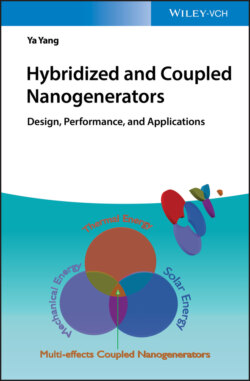Читать книгу Hybridized and Coupled Nanogenerators - Ya Yang - Страница 14
1.2.3 Other Hybridized Nanogenerators
ОглавлениеSmart cities can be realized by integrating wind and solar energies scavenging units with city buildings to power wireless sensor networks. However, it is very difficult to integrate conventional wind harvesters with Si‐based solar cells, as illustrated in Figure 1.4a. The largest issue is the required rotation motion for the conventional wind harvesters, which is not suitable for integrating it with planar solar cells, as displayed in Figure 1.4b. In 2016, Prof. Ya Yang first designed a new hybridized nanogenerator by integrating silicon solar cells with a wind‐driven TENG in one device for harvesting wind–solar energies at the same time [30]. As illustrated in Figure 1.4c, these hybridized nanogenerators can be effectively integrated on the top surface of houses because of the non‐rotating part of the TENGs. Figure 1.4d presents an optical image of the hybridized nanogenerator, where the solar cells can be fixed on the surfaces of the wind‐driven TENG. Under a device size of 12 × 2.2 cm, the total output power of the solar cells is 8 mW, but the corresponding output power for the wind‐driven TENG can be about 26 mW. If the hybridized nanogenerator array can be arranged on the top surfaces of city buildings to simultaneously scavenge wind and solar energies, self‐powered sensor networks in smart cities can be realized in future.
Figure 1.4 Hybridized nanogenerator for scavenging solar and wind energies. (a) Photograph of conventional wind turbine generator. (b) Photograph of the solar cells on the top of a building. (c) Schematic diagram of the hybridized nanogenerators on the roof of a house model. (d) Photograph of the fabricated hybridized nanogenerator.
Source: Reproduced with permission from Wang et al. [30]. Copyright 2016, American Chemical Society.
For this technique, the solar cells can be easily attached on the wind‐driven TENGs. The most important issue is how to realize the large size of the device. To solve this issue, Prof. Ya Yang first designed the meter‐scale TENG to harvest wind energy and applied the corresponding patents, as shown in Figure 1.5a, where corresponding output current signals of single device can be larger than 100 μA, as depicted in Figure 1.5b. Figure 1.5c illustrates that the corresponding output power of the fabricated TENG is larger than 220 mW for the single device. Figure 1.5d displays that TENGs with different sizes can be fabricated, which is very important for meeting different environmental needs. This technique has demonstrated the ability of designing different devices with sizes ranging from centimeters to hundreds of meters to simultaneously scavenge wind and solar energies, as illustrated in Figure 1.5e [33].
Figure 1.5 Large‐scale triboelectric nanogenerators (TENGs) for scavenging wind energy. The large‐scale TENG to scavenge wind energy was first designed and fabricated by Prof. Ya Yang before 15 March 2018. The corresponding patents have been also filed based on it. (a) Photograph of the designed large‐scale TENG. The data were provided by Prof. Ya Yang. (b) The output current signals of the large‐scale TENG. The data were provided by Prof. Ya Yang. (c) The output current signals of the large‐scale TENG under different loading resistances and the corresponding output powers. The data were provided by Prof. Ya Yang. (d) Photograph of the designed different‐sized TENGs. The data were provided by Prof. Ya Yang. (e) An illustrative diagram of large‐scale TENGs wind walls on farm land.
Source: Reproduced with permission from Chen et al. [33] Copyright 2017, John Wiley and Sons.
Figure 1.5d illustrates a schematic diagram of a power station including thousands of large‐scale TENGs. Before 15 March 2018, Prof. Ya Yang first designed the large‐scale “electric wall” including tens of TENGs as a wall for scavenging wind energy and applied the corresponding patents, as displayed in Figure 1.6a. Each wind wall can provide the electric power outputs ranged from 1 W to 10 W, which can easily light up tens of lamp bulbs, as presented in Figure 1.6b. One thousand of these wind walls can provide a total electric power output up to about 10 kW, which can be utilized in many windy places such as both sides of high‐speed train road, desert island, sea surface, mountain area. If the solar cells were fixed on the devices, the energy produced can be much larger than 10 kW. Several megawatt or gigawatt power stations can also be designed based on this new technique. The electric power obtained can be transformed by power substations and then be transported through cables for long‐distance electricity supplement. These large‐scale new hybridized nanogenerators have potential applications in the wind and solar energies scavenging field.
Figure 1.6 Large‐scale triboelectric nanogenerators (TENGs) for scavenging wind energy. The mobile meter‐scale wind wall includes tens, even hundreds, of meter‐scale TENGs, which was first designed and fabricated by Prof. Ya Yang before 15 March 2018. The corresponding patents have been also filed based on it. (a) Photograph of the large‐scale TENGs together with Prof. Ya Yang. The time of taking the photo is 15 March 2018. The data were provided by Prof. Ya Yang. (b) Photograph of 16 LED bulbs lighted by the TENGs to scavenge wind energy. The data were provided by Prof. Ya Yang.
Source: Courtesy of Prof. Ya Yang.
